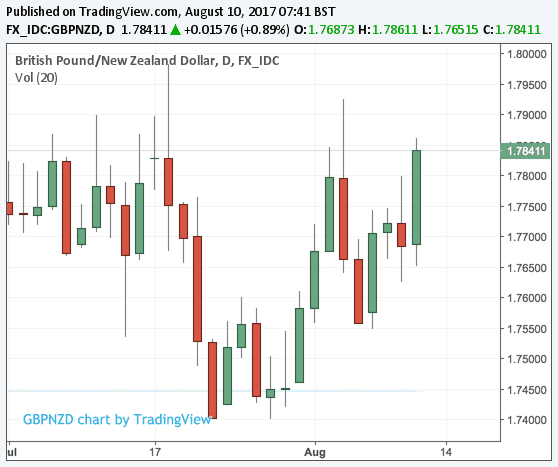The New Zealand Dollar Falls as RBNZ Warns on Currency Strength, seen "Aggressively on Hold" on Rates
- Written by: Gary Howes
-

The New Zealand Dollar is easily the day's worst-performing currency after it fell in the wake of the Reserve Bank of New Zealand’s August MPS event at which the country’s Official Cash Rate was left unchanged at 1.75%.
The RBNZ struck a cautious tone regarding the outlook in the Monetary Policy Statement, reiterating that policy would stay accommodative “for a considerable period” and that “numerous uncertainties” remained.
It was the Bank's views on the rising value of the currency that ultimately prompted a decline as it signalled its readiness to intervene with what it sees as an overvalued NZ dollar.
"The Bank declined to change its cash-lending interest rate from 1.75%, but emphasised that the rate could fall if the Kiwi does not weaken. Shortly after RBNZ Assistant Governor John McDermott repeated the message in a media conference, the Kiwi tumbled 0.60% against the US greenback to 0.7267," notes Arnaud Masset, an analyst with Swissquote Bank.
Indeed; the New Zealand Dollar slipped lower against all majors.
The slip allows the Pound to New Zealand Dollar exchange rate to move up to 1.78 in London morning trade ensuring the August rally in the exchange rate remains intact:

NZD/USD is down 0.96% having reached 0.7256, while the EUR/NZD exchange rate is up 0.93% at 1.6127.
In particular the RBNZ changed the language in its OCR statement to say that a lower NZD ‘is needed’ rather than ‘would be helpful’.
Parliamentary testimony has subsequently suggested this is a first step towards FX intervention.
Chris Turner, Head of Strategy at ING Bank N.V. notes that while New Zealand is not a G20 country and thus may not feel bound by any G20 agreement to avoid competitive devaluations, it is still a very difficult political environment for FX intervention.
"Unless the RBNZ is prepared to cut rates, we doubt the market will take NZD much lower on the threat of intervention alone - meaning that NZD/USD should probably find support in the 0.7200/7250 area today. A break below there probably requires a sharp move higher in US yields or a more decisive turn in the risk environment," says Turner.
Get up to 5% more foreign exchange by using a specialist provider by getting closer to the real market rate and avoid the gaping spreads charged by your bank for international payments. Learn more here.
Agressive Hold
Economic growth in the March quarter was weaker than the RBNZ had expected, but an improvement was anticipated.
Inflation had eased, but was still expected to reach the midpoint of the target range.
“The comments continue to suggest that official interest rate settings will remain untouched for some time,” notes Janu Chan, Senior Economist at St. George Bank.
Stephen Toplis at BNZ describes the RBNZ as being “aggressively on hold” which suggests markets are discounting the prospect of any interest rate rise in the near-future.
Currency’s tend to rise in anticipation of higher interest rates at their central bank and reverse when the date for such a move is pushed back.
“The RBNZ is stuck in neutral. Any increase in interest rates is seen as simply not plausible given that inflation continues to sit below the RBNZ’s target band mid-point,” says Toplis.
There is meanwhile little need to cut interest rates as the country’s low inflation is seen as transitory and the robust economy simply does not need any more stimulus at this juncture.


The RBNZ cut its short term inflation forecasts, forecasting annual inflation to now slump to 0.7% by March 2018.
This reflects a combination of the lower starting point for inflation, a higher NZ Dollar and a fall in petrol prices.
Concerning the outlook, markets appear to be expecting an interest rate rise in September 2018. The RBNZ would however only move on an MPS event, which does not fall in September.
This leaves August or October as being viable dates which suggests by choosing September the market is hedging bets on either an August or October move.
“But let’s face it, we are flying blind making a call for what the RBNZ will be doing in the middle of next year,” says Toplis.
The analyst notes:
- We don’t know who the Governor or Deputy Governor will be (this was Governor Wheeler’s last throw of the dice);
- We don’t know who the Government or Minister of Finance will be (and certainty around this is diminishing by the minute);
- We don’t know if the Policy Targets Agreement will be the same as it is today.
“All of these things could, clearly, have a significant bearing on the evolution of monetary policy,” says Toplis.




